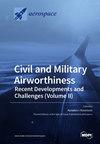利用双压缩角表面电弧等离子体致动器控制高超音速冲击波/边界层相互作用的实验研究
IF 2.1
3区 工程技术
Q2 ENGINEERING, AEROSPACE
引用次数: 0
摘要
压缩转角激波/边界层相互作用是超声速/高超声速流动中典型的激波/边界层相互作用问题。在以往的研究中,分离流通常由单个激波引起。然而,在实际的飞机表面构型中,两级压缩甚至多级压缩都会产生更为复杂的SWBLI问题。多通道激波结构使得流场结构更加复杂,也对流动控制方案提出了更高的要求。为了探索双压缩转角激波/边界层相互作用问题的流动控制方法,在来流速度Ma 6.0同时具有噪声流场和安静流场的情况下,采用高能流动脉冲电弧放电阵列对双压缩转角激波/边界层相互作用进行了控制实验研究。结果表明:施加UDC = 0.5 kV驱动时,热气体质量流向的影响范围约为65 mm,可以在一定程度上减弱激波强度;当应用UDC = 1 kV驱动时,热气体质量流向的影响范围扩展到85 mm,该驱动对流场有明显的控制效果。通过对驱动流场高速纹影图像的时空演化分析和空间梯度阈值处理,验证了利用高能流动脉冲电弧放电阵列控制高超声速双压缩转角激波/边界层相互作用的可行性。揭示了高能流动脉冲电弧放电阵列在双压缩角激波/边界层相互作用下的控制规律。本文章由计算机程序翻译,如有差异,请以英文原文为准。
Experimental Investigation on the Control of Hypersonic Shock Wave/Boundary Layer Interaction Using Surface Arc Plasma Actuators at Double Compression Corner
Compression corner shock wave/boundary layer interaction (SWBLI) is a typical shock wave/boundary layer interaction (SWBLI) problem in supersonic/hypersonic flows. In previous studies, the separation flow is usually caused by a single shock wave. However, in the actual aircraft surface configuration, two-stage compression or even multistage compression will produce more complex SWBLI problems. The multi-channel shock structure makes the flow field structure more complicated and also puts forward higher requirements for the flow control scheme. In order to explore a flow control method for the double compression corner shock wave/boundary layer interaction problem, an experimental study is carried out to control the double compression corner shock wave/boundary layer interaction with a high-energy flow pulsed arc discharge array under the condition that the incoming flow velocity Ma 6.0 has both noise flow fields and quiet flow fields. The results show that when UDC = 0.5 kV actuation is applied, the influence range of the hot gas mass flow direction is about 65 mm, which can weaken the shock wave intensity to a certain extent. When UDC = 1 kV actuation is applied, the influence range of the hot gas mass flow direction extends to 85 mm, and the actuation has a significant control effect on the flow field. Through spatio-temporal evolution analysis and spatial gradient threshold processing of high-speed schlieren images of actuated flow fields, the feasibility of controlling the hypersonic double compression corner shock wave/boundary layer interaction by using a high-energy flow pulsed arc discharge array is verified. The control law of a high-energy flow pulsed arc discharge array acting on the double compression corner shock wave/boundary layer interaction is revealed.
求助全文
通过发布文献求助,成功后即可免费获取论文全文。
去求助
来源期刊

Aerospace
ENGINEERING, AEROSPACE-
CiteScore
3.40
自引率
23.10%
发文量
661
审稿时长
6 weeks
期刊介绍:
Aerospace is a multidisciplinary science inviting submissions on, but not limited to, the following subject areas: aerodynamics computational fluid dynamics fluid-structure interaction flight mechanics plasmas research instrumentation test facilities environment material science structural analysis thermophysics and heat transfer thermal-structure interaction aeroacoustics optics electromagnetism and radar propulsion power generation and conversion fuels and propellants combustion multidisciplinary design optimization software engineering data analysis signal and image processing artificial intelligence aerospace vehicles'' operation, control and maintenance risk and reliability human factors human-automation interaction airline operations and management air traffic management airport design meteorology space exploration multi-physics interaction.
 求助内容:
求助内容: 应助结果提醒方式:
应助结果提醒方式:


